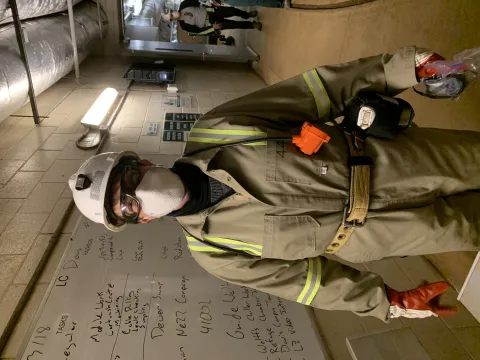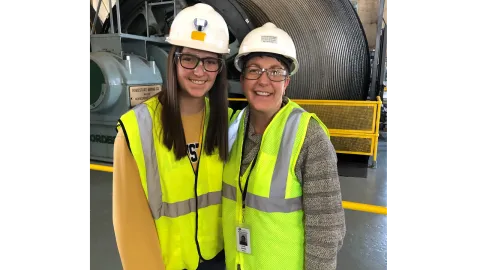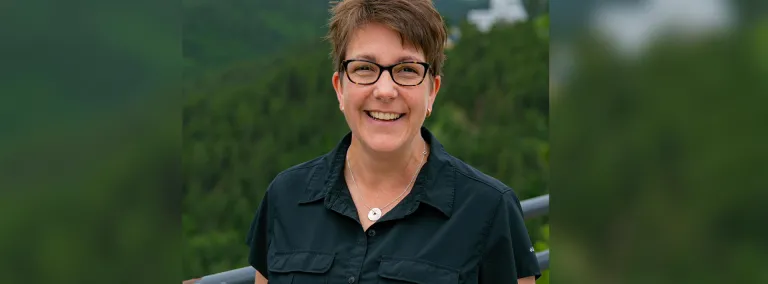Meet SURF’s new Director of Education & Outreach
Reiner discusses the value of critical thinking and the difficulties of teasing math out of hiding
Nicol Reiner joined the Education and Outreach team at Sanford Underground Research Facility (SURF) during one of the most challenging years in public education. Starting in March 2020, Reiner worked with the E&O team to leverage underground science at SURF and support STEM educators even as the COVID-19 pandemic brought unprecedented challenges to teachers across the globe. This month, Reiner became the new director of E&O at SURF.
“As a math educator, Nicol brings the ‘M’ to our ‘STEM’ efforts,” said Deb Wolf, the former director of E&O who now leads Education, Communication and IDEA efforts at SURF. “Nicol has the ability to think very deeply and see connections between what seem like disparate pieces. She ties these pieces together to create something new.”
Reiner’s ability to make connections is anchored in her philosophy on mathematics.
“Math is truly about patterns—noticing patterns, describing patterns, figuring out shortcuts for patterns, figuring out what patterns can tell us,” Reiner said. “You see that all over at Sanford Lab.”
We recently caught up with Reiner to discuss her experiences as an educator and what is on the horizon for the E&O team. The interview has been condensed and edited for clarity.
People often consider math to be a “pen and paper” discipline. How does the “M” in “STEM” show up daily around an underground research facility?
Modern mathematics lives in and between all of science. It's just a matter of teasing it out to look at it. And although you can tease it out, it's way more fun to look at it in the context of science and engineering.
In the LZ experiment, researchers are looking for a very specific blip in their data. They’ve used mathematics to determine the pattern they expect to see. When they see a disruption in that pattern, they know they’ve discovered something.

But it's also in the engineering. When I go into the hoistroom and I look at those hoists—how they're shaped and how they've coiled the rope very specifically—there are tons of structural mathematics that underlie why that engineering works.

What is the most valuable lesson you learned from a student?
I think as we grow older, we forget to be curious. Students remind us to ask questions.
When I teach mathematics, they ask questions I had forgotten about. They would ask me, “Why does this matter?” And then I had to think about that. Why is this relevant? Why should they care? Sometimes I had good answers and sometimes I didn't. But they forced me to be curious about those fundamental questions again.
You’ve spent much of your career supporting both early-career and veteran teachers. What's something you wish you could tell every teacher?
Intentional planning is key. Often, relevant, rigorous, quality, equitable learning experiences don't happen organically. That intentional planning is actually what gives kids the space to have autonomy over their learning. Because you've provided the right amount of structure, guidance and freedom, students can experience it and ask questions. And you can be nimble and flexible in helping them have a great learning experience.
And the second thing I would tell them is relationships is the other key. Unless you build good relationships, learning doesn’t happen. Teachers have to let their students know who they are. In those relationships, students can take risks in learning. Students need to feel safe to make mistakes and take risks and try things and ask questions.
What is on the horizon with the Education and Outreach team? What do these programs look like in today’s “new normal”?
During the pandemic, our work never stopped. We still offered support to teachers and students across the state for effective science learning experiences. We had to virtualize things. And because of that, we reached students we've never reached before. That virtual component will never go away. When we get back to face-to-face field trips, presentations and professional development, the virtual piece will be a compliment
This summer, we get to practice this transition with hybrid virtual and face-to-face professional development courses. We’ll host a five-day professional development at Black Hills State University, which we do each year. And we're collaborating with the South Dakota EPSCoR and the South Dakota Department of Education to provide additional professional development for science and math teachers as well.
So, in addition to our own professional development programs, we partner with other entities to support as many teachers as possible. It always goes back to our mission to support high quality, equitable, effective, engaging and rigorous science education.
How can the community get involved?
The best way for the community to get involved is to encourage the kids in their lives to ask questions, to think critically and to problem solve. Encourage them to take risks, make mistakes and learn from those mistakes.
An easy way to encourage that is by seeking out resources from SURF. That could be attending Deep Talks or Neutrino Day. It could be reading Deep Thoughts. It could even be asking your student’s science teacher if they know about the resources SURF offers.
Our kids will be the ones who solve the problems of the world we're living in. Whether they choose to be scientists or mathematicians or something very different, they still need to be critical thinkers and problem solvers who are willing to take risks and think broadly about the world around us.
The Education and Outreach program is a collaborative venture between Sanford Underground Research Facility and Black Hills State University. Our goal is to use the excitement and promise of deep underground science and engineering to inspire and engage students, educators and the wider community through a variety of programming.
